Fighting Jim Crow on the High Seas - The Meeting at Cooper Union
The settlements of the Spring Strike on the West Coast didn’t hold, and on October 30th, 1936, west coast seamen and longshoremen walked off their jobs.
On the East Coast, a committee of radical rank-and-filers within the ISU—the Seamen’s Defense Committee—urged a sympathy strike in support of the west coast strikers. On October 31st the crew of a passenger ship in New York Harbor staged a sit-down strike.
An emergency meeting was called that very night—October 31st, 1936—in the Great Hall at Cooper Union—by leaders of the do-nothing International Seamen’s Union. They were desperate to keep sympathy strikes from spreading on the East Coast.
The drama of that mass meeting stands out in the annals of labor history—a turning point with monumental repercussions. It occurred in the Great Hall in Cooper Union—at the same podium where two other turning points in American history occurred—Abraham Lincoln’s 1860 anti-slavery speech, thought to be the key to his election later that year, and young garment worker Clara Lemlich’s 1909 call for a strike in the face of entrenched union leaders’ call for calm and acceptance.
That earlier rank-and-file uprising was eerily echoed in the Great Hall in October 1936, as rank-and-file seamen rose up against complacent leaders and demanded action.
Abraham Lincoln Speaks in the Great Hall
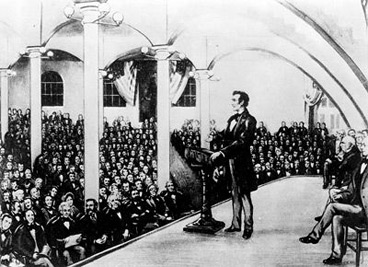 Drawing courtesy of The Cooper Union, circa 1910.
Drawing courtesy of The Cooper Union, circa 1910.
Cooper Union’s Great Hall has provided the stage for a number of dramatic turning points in the history of our country. Abraham Lincoln’s powerful February 27, 1860 “Right Makes Might” speech was credited with helping him win the nomination for president.
At the same podium nearly half a century later, Samuel Gompers spoke at a meeting of garment workers, on November 22, 1909. Clara Lemlich, a nineteen year old garment worker from Ukraine, stood up from the audience, came to the podium, and started a rank-and file-uprising that would become known as the “Uprising of 20,000.”
At the Podium in the Great Hall
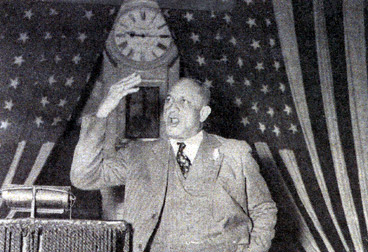 Photograph from Gottlieb, This is the NMU (1956), courtesy of Tamiment Library, New York University.
Photograph from Gottlieb, This is the NMU (1956), courtesy of Tamiment Library, New York University.
The tasseled podium in the Great Hall at Cooper Union had seen many historic moments before International Seamen’s Union officer David Grange stepped up to that same podium on October 31, 1936, to chair an emergency meeting of the union. The ISU had called the meeting in order to prevent east coast seamen from going on strike in support of their west coast counterparts—but 1500 rank-and-file seamen showed up determined to call a strike.
Grange was not only an ISU officer but also on a $200/month retainer from half a dozen East Coast steamship companies. Ironically, this enemy of the rank-and-file was an African American union officer—in the racist International Seamen’s Union. He came from the Marine Cooks and Stewards division of this union—a division representing the only jobs blacks were allowed to hold.
I.S.U. Officer David Grange
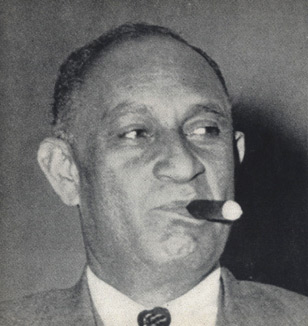 Photograph from Gottlieb, This is the NMU (1956), courtesy of Tamiment Library, New York University.
Photograph from Gottlieb, This is the NMU (1956), courtesy of Tamiment Library, New York University.
Strike veteran Robert McElroy speaking at Cooper Union, Nov. 3, 1986 (on the 50th anniversary of the Fall Strike):
On October 31st, 1936, 50 years ago this past Friday, I was sitting right here beside Mulderig, Francis Mulderig who later turned out to be a first-class fink, but who in 1936 was fighting for the rank-and-file control of the International Seamen’s Union. And I was sitting right beside him. The year was 1936. The U.S. economy was a basket case. Shipping was down to next to nothing We were so hungry our bellies were rubbing against our backbones.
This pitiful example of humanity to my right is a representation of Davie Grange. The head of the Marine Cooks and Stewards Union, second ranking official in the International Seamen’s Union out of which the NMU was founded. He used to be quite a sight: $300 suits—quite an item in 1936—spats, silk shirts, hand-rolled monogram cigars from Havana, his signature was a live rose which he wore in his boutoniere and was in a vial of water. He regularly gaveled meetings to order with his gun.
Famed for gaveling union meetings to order with his .45 revolver, Grange (shown here with his cigar) was determined to quash any talk of a port-wide strike. He had ISU strong men and NYC policemen there to help keep the meeting under control. After dominating the meeting for three hours, quashing calls for a strike, he adjourned it, and had the lights turned off. Hollering filled the Great Hall.
Seaman Mulderig Collecting Donations
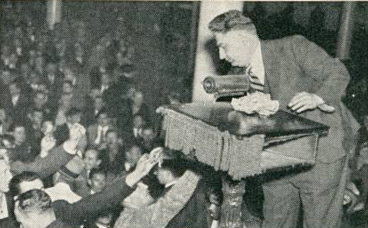 Photograph from Gottlieb, This is the NMU (1956), courtesy of Tamiment Library, New York University.
Photograph from Gottlieb, This is the NMU (1956), courtesy of Tamiment Library, New York University.
As the clamor rose in the dark hall, seaman Francis Mulderig shouted—in the loudest voice anyone had ever heard: “EVERYONE SHUT UP AND STAY IN YOUR SEATS!… SOMEONE TURN ON THE GODDAMNED LIGHTS!” Over and over again, Mulderig repeated these orders. Single-handedly, he quieted the Great Hall of Cooper Union.
Mulderig is shown here collecting donations to keep the lights on so the Cooper Union meeting could continue. The “tarpaulin muster” worked, and $146 in one-dollar bills was collected. The janitor was paid, the lights went on, and the meeting continued.
Joe Curran at Cooper Union
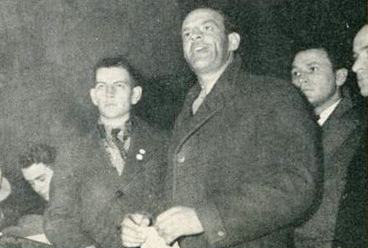 Photograph from Gottlieb, This is the NMU (1956), courtesy of Tamiment Library, New York University.
Photograph from Gottlieb, This is the NMU (1956), courtesy of Tamiment Library, New York University.
Strike veteran Robert McElroy speaking at Cooper Union, Nov. 3, 1986 (on the 50th anniversary of the Fall Strike):
When the lights finally came on 10 minutes or so later, the hall had been transformed. All the rats had fled. The goons, the stooges, and the pie-cards had lost their game plan – caught unawares. And they had decided they’d better get the hell out. The hall was still packed – but only rank-and-filers were left. In came our rank-and-file leaders from outside – who’d been kept outside for all this time by the I.S.U. We realized at that point that the rank-and-file seamen were in control of the union.
Joe Curran, who had been the leading light in the SS California sit-down strike, and the bruising Spring Strike that followed, was barred by I.S.U. officials from attending the Cooper Union meeting.
At 10:30pm rank-and-file seamen took control of the Great Hall, and a defiant Curran took the stage and called for the strike vote Grange had been determined to avoid.
Seamen in the hall unanimously voted their support.
Curran and half a dozen rank-and-file leaders from the Spring Strike had formed the Seamen’s Defense Committee when that strike fell apart. They knew there would be another strike, and they were determined to be prepared—armed with a strike fund and advance preparations to feed and house those on strike.
Once again Curran inspired a passionate group of rank-and-file seamen.
The 82-day “Fall Strike” had begun. It spread to many more ports than the Spring Strike, and, according to contemporary chroniclers, it cost the lives of as many as 28 seamen.




